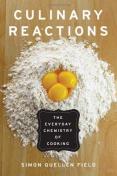BKMT READING GUIDES
Culinary Reactions: The Everyday Chemistry of Cooking
by Simon Quellen Field
Paperback : 288 pages
0 club reading this now
0 members have read this book
When you’re cooking, you’re a chemist! Every time you follow or modify a recipe, you are experimenting with acids and bases, emulsions and suspensions, gels and foams. In your kitchen you denature proteins, crystallize compounds, react enzymes with substrates, and nurture desired ...
Introduction
When you’re cooking, you’re a chemist! Every time you follow or modify a recipe, you are experimenting with acids and bases, emulsions and suspensions, gels and foams. In your kitchen you denature proteins, crystallize compounds, react enzymes with substrates, and nurture desired microbial life while suppressing harmful bacteria and fungi. And unlike in a laboratory, you can eat your experiments to verify your hypotheses.
In Culinary Reactions, author Simon Quellen Field turns measuring cups, stovetop burners, and mixing bowls into graduated cylinders, Bunsen burners, and beakers. How does altering the ratio of flour, sugar, yeast, salt, butter, and water affect how high bread rises? Why is whipped cream made with nitrous oxide rather than the more common carbon dioxide? And why does Hollandaise sauce call for “clarified” butter? This easy-to-follow primer even includes recipes to demonstrate the concepts being discussed, including:
· Whipped Creamsicle Topping—a foam
· Cherry Dream Cheese—a protein gel
· Lemonade with Chameleon Eggs—an acid indicator
Discussion Questions
No discussion questions at this time.Book Club Recommendations
Recommended to book clubs by 0 of 0 members.
Book Club HQ to over 88,000+ book clubs and ready to welcome yours.
Get free weekly updates on top club picks, book giveaways, author events and more








